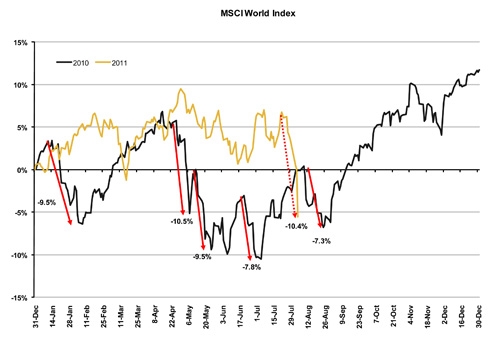Personal Wealth Management / Economics
Corrective Action
Understanding and separating the negatives from the positive realities can help guide your investing decisions.
Major US stock indexes dropped into official correction territory Thursday, leaving many investors wondering what to do next and if an even steeper downturn is likely.
In our view, current market action is much more characteristic of a correction than a bear market. In that way, recent market action is very similar to that experienced just mid-year 2010—and 2010 was overall a fine year for stocks, though with plenty of volatility along the way. (See Exhibit 1)
Exhibit 1: 2010 and 2011 Market Volatility
Source: Thomson Reuters, Fisher Investments Research, MSCI World IndexNet Return 12/31/2009-8/4/2011.
Corrections are short, sharp drops of 10% to around 20% that later and nearly just as quickly reverse themselves as stocks carry on to higher levels. They occur frequently in bull markets and are to be expected from time to time. They are driven, usually, by a major, often sensational story that can drown out almost all other news—whether positive or negative. On the other hand, bear markets historically haven’t started with a bang. They have rolling, grinding tops and are usually marked (though not always) by complacency. Bear markets are caused by markets pricing in worsening fundamentals that outweigh any positives.
Why does that matter? Because if this is a correction, the most prudent move is to stay put and not sell at relative lows. If it’s a bear market, a grinding top means you have time to develop conviction this is in fact a bear market, and you may have a better point to exit later on as the market continues rolling—and you can avoid getting whipsawed.
Either way, the decision to stay put or exit should not hinge on trying to avoid very near-term volatility—which is no doubt emotionally trying. Rather, it should hinge on your outlook for the next 12 months or so. We believe the greater likelihood is stocks are overall higher 12 months from now.
Negativesexist today. The eurozone still lacks a clear, cohesive plan for dealing with its fiscally weaker members. Unemployment remains elevated, and the US economy did seemingly hit a soft patch in Q1 that continued into Q2. But there’s never been a point in history that lacked challenges to the economy or capital markets. Those realities must be weighed against positive realities like:
- Global GDPoverall has been positive and is projected to remain so for this year.
- Expectations broadly continue to be for the US to re-accelerate through year-end 2011.
- Global trade continues to expand, particularly in Emerging Markets, an important source of global demand.
- Global economic metrics, though experiencing normal volatility, remain solidly expansionary.
- Interestingly, AAA-rated corporate bondsare near year-to-date lows, and bond rates have fallen this year nearly across the board—a powerful vote of confidence from the market that a recession isn’t likely. If the market believed corporate default risk were higher now, investors would be demanding higher rates, not lower.
- Similarly, and amazingly overlooked, corporate earnings growth rates continue to beat expectations and by a broad margin. Increasing corporate profitability also doesn’t paint a picture of an increasingly troubled economy.
- Though we anticipated see-sawing sentiment this year, sentiment now is decidedly in the downward “saw” position—a positive. When reality (likely) turns out better than too-dour expectations, sentiment catching up is an additional tailwind for stocks. (Part of the reason the recovery from corrections typically is fast and steep.)
As for the negatives, as we’ve discussed here, Europe is taking its time getting its house in order, but they have a substantial backstop through 2013 and continue to show their willingness to maintain the union—though they’re taking their time. America’s soft patch can be attributed, at least in part, to supply chain and production disruptionsfrom Japan’s horrific earthquake, and those issues appear to be abating already. What’s more, growth rate volatility is normal and not indicative of future trouble. Finally, high unemployment is politically a trying issue but economically is a symptom of past weakness, not a cause of future weakness.
Overall, recent market action, though certainly frustrating to live through, is largely in line with what we expected for this year—choppy action that overall nets fairly muted broad market returns. Trying to market-time around near-term swings can increase transaction costs and taxable consequences but likely doesn’t improve relative or absolute performance and may mean missing the sudden reversal of what is likely a fairly normal market correction.
If you would like to contact the editors responsible for this article, please message MarketMinder directly.
*The content contained in this article represents only the opinions and viewpoints of the Fisher Investments editorial staff.
Get a weekly roundup of our market insights
Sign up for our weekly e-mail newsletter.

You Imagine Your Future. We Help You Get There.
Are you ready to start your journey to a better financial future?

Where Might the Market Go Next?
Confidently tackle the market’s ups and downs with independent research and analysis that tells you where we think stocks are headed—and why.






